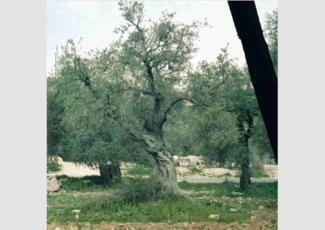Text by Elle Kurancid, photos by Bryony Dunne | (Jadaliyya) | – –
Olive tree felling is a longtime strategy of Israel’s occupation regime in the West Bank and Gaza Strip. Since 1967, an estimated 800,000 Palestinian olive trees have been destroyed by Israeli authorities and settlers.
In February 2015, Irish-born filmmaker and photographer Bryony Dunne traveled across the West Bank and encountered evidentiary support for such activity (in tree stumps and civilian stories). Over the course of one week, she moved through Israeli checkpoints, and around Israeli settlements and military bases, while heading north to the Palestinian city of Jenin, staying with five Palestinian families along the way. These families earn their livelihood farming either olives or almonds as members of Canaan Fair Trade, a cooperative that supports approximately 1,700 small farmers throughout the occupied West Bank in the sale of produce to international markets.
[Olive tree, Burqin, north Palestine, 2 July 2015. Photo by Bryony Dunne.]
“I’ve learned that the strength of the olive tree’s root system is such that it can regenerate itself in spite of being chopped, bulldozed or torched,” Dunne says to me during our interview at her studio in Cairo, just a ten-minute walk from Tahrir Square. Initially, she went to Palestine with clear intention: “I’d quietly photograph the beautiful agricultural landscapes—mainly olive and almond trees—that are nurtured by local Palestinian farmers, as opposed to the loudness of the walls, fences, tanks, checkpoints, and settlements,” she says. “What do you mean by ‘quietly’?” I ask, adding, “And by ‘loudness’?” After a long pause, she replies, “Well, I thought, ‘who am I to approach the Israeli-Palestinian conflict?’ as I’m not directly living through it. And, ‘if the trauma of a place has been so heavily photographed, how do you get people, myself included, to see something else?’”
Three weeks before setting off, Dunne purchased a vintage Hasselblad 500C film camera. “There shouldn’t have been any faults with it,” she says, having had it inspected by a Hasselblad technician. But after developing the negatives back in Cairo, an anomaly decisively surfaced: due to a malfunction in the camera (wherein the rubber placeholder for the film slipped with each slide), all seventy-two of her photographs from Palestine were imprinted with a thick black line running diagonally across either the upper right or lower left corner of the frame. “They’re all ruined, every last photograph,” she recalls thinking while quickly shuffling through the collection. However, in what could be construed as a spontaneous Rorschachian test, Dunne soon found herself associating the thick black lines with Palestinian oppression. “These images, they’re simultaneously quiet and loud,” I say to her. “I know,” she replies, “this is one of the strangest coincidences.”
For me, it’s one of the strangest too: these affected frames show, as it were, the proverbial calm before an imaginable bulldozing, chopping, torching or uprooting. Accordingly, Dunne has titled this collection Imprinted, explaining, “Everywhere I went in Palestine, every Palestinian I met, you know, you can’t get away from the trauma of what’s happened on this land and what’s happening right now.”
She remembers an olive orchard of approximately sixty trees, situated between Jenin and the town of Burqin, belonging to one of her host families. Approaching the center of the orchard she saw a row of three stumps. “[They had] new shoots growing out,” she says, staring into the photograph of them, “and the tree in the foreground, look at its trunk, it’s been hacked at.” I point to a woman in the background, who sits under an olive tree to the left of the frame. “She’s an olive farmer and mother of four in her late forties,” says Dunne, who withholds the family members’ names for security reasons. “About a decade ago these three trees in her orchard were cut down by Israeli soldiers. That was just one difficult event in a long sequence of things being turned upside down for this family.”
Dunne tells me that the woman’s husband, also an olive farmer in his late forties, spent several years in an Israeli prison as a young man “for reasons which he said are political.” The story of their eldest son, a young man now in his early twenties, is a similar one: “Israeli soldiers arrested him for charges of speaking out against the occupation on Facebook. He is supposed to be released [in the next few months] after three years in prison.” They told Dunne that in April 2002, during the Second Intifada, they opened their doors to families who fled the Jenin refugee camp. And for a few years following that, an Israeli tank was parked in the immediate vicinity of their home.
“Loudness” was, and still is, inescapable.
Staring into that same photograph, Dunne says to me, “The families I met are rooted in this land—” I interject, scrutinizing her pun, “What do you mean by ‘rooted’?” After a long pause, she replies, “They’re content…I mean, these families are not content with the situation in the West Bank, of course, but they’re completely content with who they are as Palestinians, with their identity and heritage, and that this land is where they want to be.”
Elle Kurancid is a journalist who studied at Ryerson School of Journalism and now lives in Cairo, Egypt. Bryony Dunne is an Irish artist whose work engages Anthropology, Sociology, Ecology, and Visual Arts. Her various projects have sought to explore human’s relationship with the landscape, and the evolution of cultivation and settlements.
Reprinted from Jadaliyya with authors’ permission.




 © 2025 All Rights Reserved
© 2025 All Rights Reserved